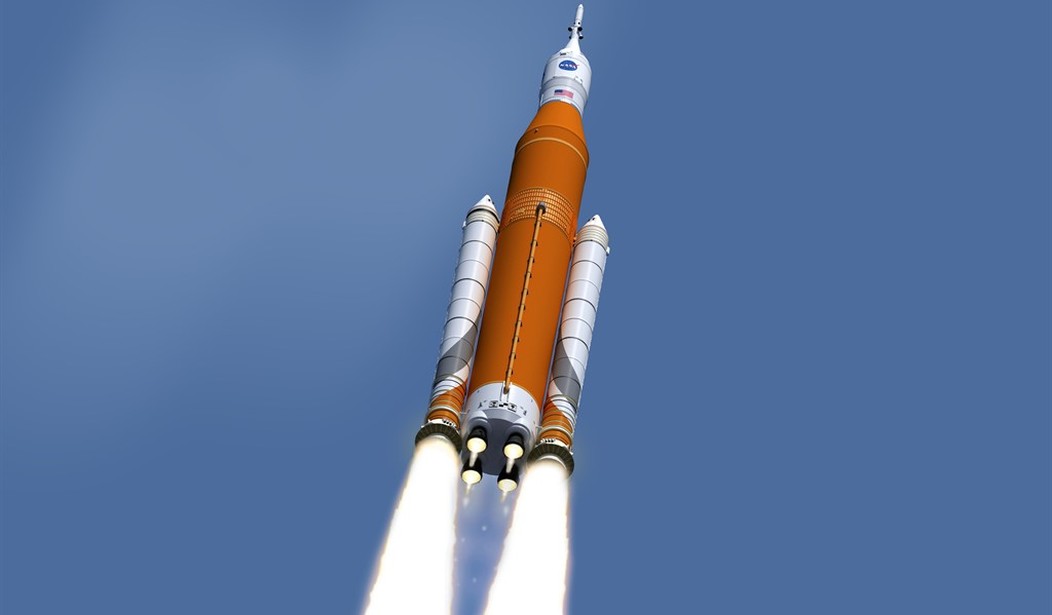Boeing’s troubled SLS super-heavy lift rocket — originally supposed to fly in 2016 — could have its maiden launch pushed back into the second half of 2022 due to an unspecified problem with an engine controller.
Kill this $30 billion boondoggle already.
Aviation Week reported earlier this week that technicians are “troubleshooting an issue with an engine controller on one of the four Aerojet Rocketdyne RS-25 engines.”
Aerojet’s RS-25 program manager, Jeff Zotti, told Aviation Week that “replacing a line or a component … we’re probably talking about multiple days.”
That’s if the problem is limited to the controller. If one of the giant RS-25 engines needs to be swapped out — something the SLS’s old-school expendable design doesn’t make easy — then “we’re probably talking about multiple weeks.”
“On top of that,” Zotti said, “we have to assess what that does and how that affects the vehicle and the integration activities that are going on.”
In other words, NASA and its contractors are still at the “we don’t know what we don’t know” stage of fixing whatever the hell is wrong this time with SLS.
NASA is still mum on the issue, according to Ars Technica’s Eric Berger, who has contacts inside the agency.
SLS’s February 12 launch hasn’t (yet) been officially scrubbed, but as Berger concluded, “A summer launch for the SLS now seems far more likely than spring.”
If ever.
In 2011, when Congress authorized spending to develop the SLS, then-Senator Bill Nelson (R-Fla.) — the pork-loving sponsor of the SLS — promised, “The cost of the rocket over a five- to six-year period in the NASA authorization bill was to be no more than $11.5 billion.”
Later he added, “If we can’t do a rocket for $11.5 billion, we ought to close up shop.”
Close. This. Shop.
We’ve spent more than double that $11.5 billion, even adjusting for inflation, and SLS — supposedly the backbone of NASA’s Moon program — has yet to fly. Here we are, just two months out from its maiden flight, and SLS might need an entire engine replaced.
Enough.
Also for our VIPs: Soros-Backed DA Larry Krasner Freed a Suspected Carjacker to Become a Suspected Murderer
SpaceX’s super-heavy Starship is set to make its first orbital test flight in January and will carry an equivalent mass to orbit as SLS.
Furthermore, Starship is fully reusable and (eventually) could enjoy a per-launch cost as low as $2 million. That’s million with an M.
SLS is fully expendable and has a per-launch cost of at least $2 billion. That’s billion with a B.
Even if SpaceX fails to meet its price goals by a factor of 100%, NASA could still afford to buy 500 Starship launches for the prices of a single SLS spaceflight.
Again, assuming SLS ever does fly.
Watching the not-at-all-funny SLS development follies, a while back I came to the conclusion that NASA would allow two or maybe three SLS flights before finally admitting (at least publicly) that we simply can’t afford this boondoggle.
But they’d have to let SLS fly those two or three times before admitting failure, in order to provide some small fig leaf to cover $30 billion wasted dollars developing the SLS and its ground-support systems.
With this week’s news about yet another reliability problem — this time with an engine controller or even an entire engine — I have to wonder if NASA can risk allowing SLS to fly even one time.
Again, assuming Boeing and its subcontractors can ever make SLS flightworthy.
SLS has got to be given a mercy killing.
But where do American taxpayers go to get our $30 billion back?










